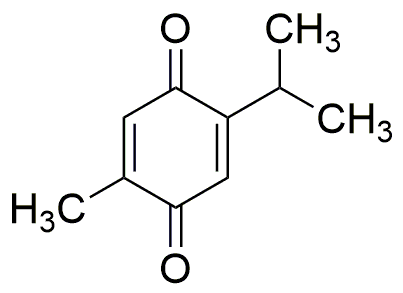Thymoquinone is widely utilized in research focused on:
- Pharmaceutical Development: Its anti-inflammatory and antioxidant properties make it a candidate for developing treatments for various diseases, including cancer and diabetes.
- Cosmetic Formulations: Thymoquinone is incorporated into skincare products for its potential to improve skin health, reduce acne, and provide anti-aging benefits.
- Food Preservation: Due to its antimicrobial properties, it is used as a natural preservative in food products, helping to extend shelf life and maintain quality.
- Research on Neuroprotection: Studies suggest it may protect brain cells from oxidative stress, making it a focus in neurodegenerative disease research.
- Aromatherapy and Essential Oils: Thymoquinone is found in essential oils, valued for its therapeutic effects, including stress relief and mood enhancement.
General Information
Properties
Safety and Regulations
Applications
Thymoquinone is widely utilized in research focused on:
- Pharmaceutical Development: Its anti-inflammatory and antioxidant properties make it a candidate for developing treatments for various diseases, including cancer and diabetes.
- Cosmetic Formulations: Thymoquinone is incorporated into skincare products for its potential to improve skin health, reduce acne, and provide anti-aging benefits.
- Food Preservation: Due to its antimicrobial properties, it is used as a natural preservative in food products, helping to extend shelf life and maintain quality.
- Research on Neuroprotection: Studies suggest it may protect brain cells from oxidative stress, making it a focus in neurodegenerative disease research.
- Aromatherapy and Essential Oils: Thymoquinone is found in essential oils, valued for its therapeutic effects, including stress relief and mood enhancement.
Documents
Safety Data Sheets (SDS)
The SDS provides comprehensive safety information on handling, storage, and disposal of the product.
Product Specification (PS)
The PS provides a comprehensive breakdown of the product’s properties, including chemical composition, physical state, purity, and storage requirements. It also details acceptable quality ranges and the product's intended applications.
Certificates of Analysis (COA)
Search for Certificates of Analysis (COA) by entering the products Lot Number. Lot and Batch Numbers can be found on a product’s label following the words ‘Lot’ or ‘Batch’.
*Catalog Number
*Lot Number
Certificates Of Origin (COO)
This COO confirms the country where the product was manufactured, and also details the materials and components used in it and whether it is derived from natural, synthetic, or other specific sources. This certificate may be required for customs, trade, and regulatory compliance.
*Catalog Number
*Lot Number
Safety Data Sheets (SDS)
The SDS provides comprehensive safety information on handling, storage, and disposal of the product.
DownloadProduct Specification (PS)
The PS provides a comprehensive breakdown of the product’s properties, including chemical composition, physical state, purity, and storage requirements. It also details acceptable quality ranges and the product's intended applications.
DownloadCertificates of Analysis (COA)
Search for Certificates of Analysis (COA) by entering the products Lot Number. Lot and Batch Numbers can be found on a product’s label following the words ‘Lot’ or ‘Batch’.
*Catalog Number
*Lot Number
Certificates Of Origin (COO)
This COO confirms the country where the product was manufactured, and also details the materials and components used in it and whether it is derived from natural, synthetic, or other specific sources. This certificate may be required for customs, trade, and regulatory compliance.


